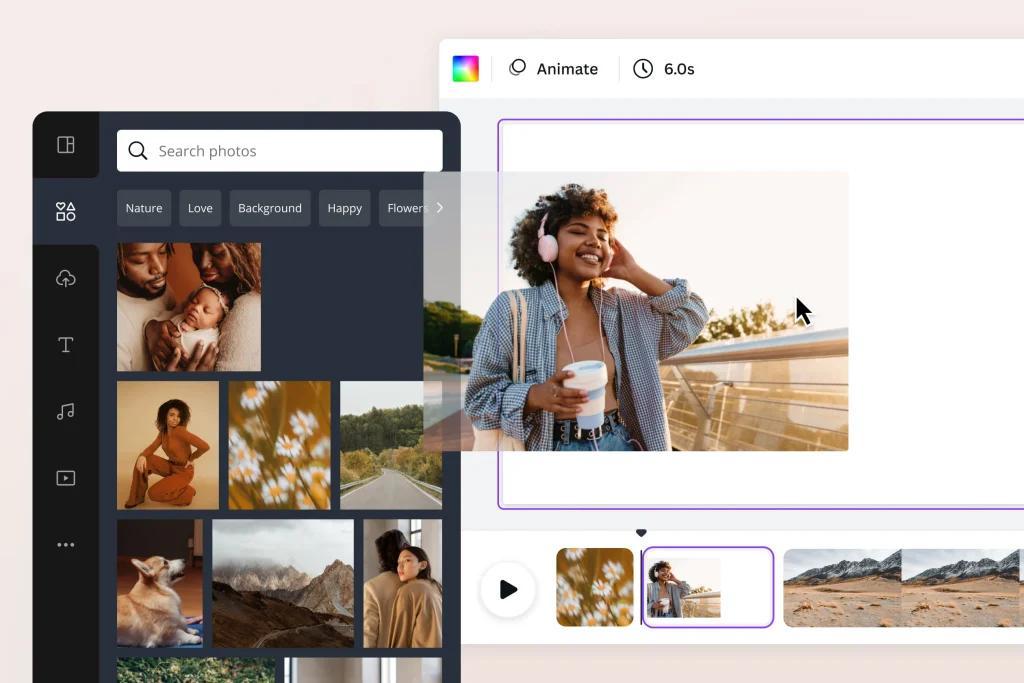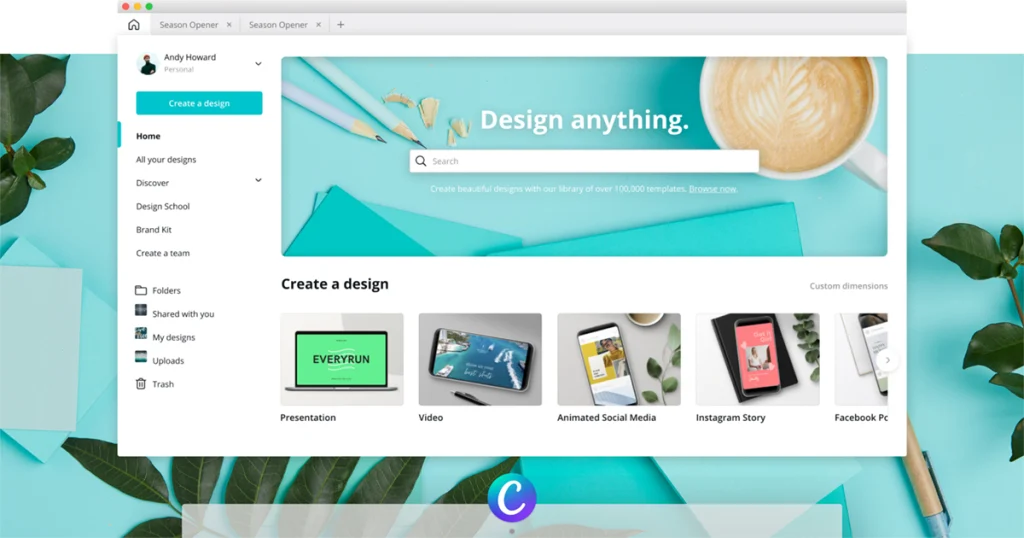Table of Contents
Introduction:
An Australian graphic design tool called Canva is used to make social media graphics, papers, posters, presentations, and other visual material. The world’s fifth-most valuable private startup is Canva. When it first debuted in 2013, the design platform served as the go-to resource for individuals and small companies looking to create stylish posters.
About Canva:
Canva is currently the most frequently used online design tool for making invitations, posters, resumes, presentations, and certifications. Roll claims that the road to the brand’s acceptability throughout the world was not a straightforward one. Unquestionably, one of the SaaS startups with the highest global growth is Canva. The internet publishing and design giant takes pride in its user-friendly but stylish product.
Canva is used by more than 10 million people for a variety of creative tasks, including creating birthday cards, posters, social media graphics, and presentations. Canva is aiming to become the most valuable software business in the world with its mission to democratise design for everyone. Armed with this vision, the organisation turned to Think & Grow’s experience to locate the ideal employee to expand and manage engineering, a vital business function.
All aspects of Canva’s company were expanding rapidly, including its user base and the addition of multilingual support. The company’s rapidly expanding engineering staff faced increased expectations when it began to operate outside of Australia.

The business realised right once that it required someone to handle the engineering role. The leadership team sought to fill the position from the beginning with a “people lead” rather than a technical lead. For the Head of Engineering role, Canva hired Think & Grow to undertake a worldwide search.
Canva needed someone who shared their attitude and goal to become an internationally significant company, not merely a technical whiz to lead the engineering staff. One important need was that the candidate be capable of managing a rapid 100 per cent development in the engineering department (100+ persons).
It was immediately clear to Think & Grow that there was a very strong likelihood that the right applicant would be coming from outside the country because of Canva’s superb job specification. Canva gave Think & Grow access to information that would only be available to a select few to help with the recruiting process. According to Think & Grow partner Anthony Sochan, “the material was comparable to what an investor would get in a secret pitch deck.” “This truly allowed us to search for the best candidate with confidence. We are really appreciative of Canva’s confidence in us.
Canva Founder & Team:
Melanie Perkins, a multibillionaire Australian digital entrepreneur, was born on May 13th, 1987. She is the co-founder and CEO of Canva. One of the newest female CEOs of a tech startup with a market cap above $1 billion is Perkins. Perkins was one of the wealthiest women in Australia as of May 2021. Melanie Perkins, Cliff Obrecht, and Cameron Adams started Canva in 2012; its headquarters are in Sidney, Australia.

Canva History:
When Perkins was just 19 years old in 2007, she had the concept for Canva. When she realised that most design programmes were costly, complicated, and inaccessible, she started teaching design programmes to her university colleagues. She imagined a straightforward, virtual, and collaborative design world.
The procedure was considerably more challenging for Perkins when he first tried to raise venture funding. After more than a hundred rejections and countless fruitless trips to Silicon Valley, she discovered her first investors. Perkins and Cliff Obrecht, the couple’s co-founder and husband, struggled for more than three years to get the company’s initial financing. 2013 saw the official introduction of Canva.
Canva Name & Logo:

Canva Highlight:
| Company Name | Canva |
| Founders | Melanie Perkins |
| Started at | 2012 |
| Competitors | Visme.Adobe Spark.Design Wizard.Easil.Snappa.Crello.Stencil.PicMonkey. |
| Website | https://www.canva.com/en_gb/ |
| Revenue | A$6 billion |
| Country | Australia |
| Customer care Email | Not Known |
| Customer care Contact details | Not Known |
| Caompany Valuation | US$26 billion |
| Industry | Tech |
| Headquarters | Sidney, Australia |
Canva Revenue:
Inc. Canva Canva raised $60 million in June 2020 with a valuation of A$6 billion, nearly twice that of 2019. Canva raised $200 million in September 2021, when its worth peaked at US$40 billion. The company’s valuation reached a plateau in September 2022 at US$26 billion.
Canva Funding & Investors:
Finally, in 2012, Melanie was able to secure $1.6 million from VC companies including Blackbird, Matrix, and InerWest Partners as well as angel investors like Bill & Lars. Their total seed raising increased to $3 million thanks to a $1.4 million grant they were able to secure from the Australian government.
There are 35 investors in Canva, including Franklin Templeton Investments and T. Rowe Price. Canva has raised $572, 6 million. Bob Iger, a former CEO of Disney, invests in and serves as an advisor to the Australian visual communications firm Canva. Founders Fund, Bessemer Venture Partners, Sequoia Capital, and other prestigious Silicon Valley investors have joined forces with Canva, an Australian graphic design business with a $26 billion valuation.
On September 14, 2021, they received money from a Venture – Series Unknown round. 35 investors have backed Canva. The most recent investors include T. Rowe Price and Franklin Templeton Investments.
Canva Revenue Model:

Create infographics, posters, presentations, logos, and other types of visual material using Canva, a graphic design tool. The platform’s primary point of differentiation is the fact that it began life as a web application. Design tools have historically been desktop programmes that had to be downloaded. Additionally, Canva’s design tools are accessible on iOS and Android devices.
As a single design tool, Canva aims to offer functionality for the whole graphic design process. The most popular characteristics include:
- standardised design templates
- changing the font, colour, size, and a variety of other aesthetic elements
- Editor using drag & drop
- Including frames or filters
All work is synced across all registered devices because the programme is hosted in the cloud (rather than locally, as with many typical desktop apps).
Canva receives revenue from marketplace fees, print items, monthly subscriptions, and course sales. Canva was first offered without charge. The goal of this plan was to draw customers and develop a steady, devoted following. That user base would develop over time through word-of-mouth and a top-notch product.
Canva has established a number of revenue streams over the last few years, from subscriptions to business solutions. However, the freemium revenue model continues to be the company’s main focus. As a result, the bulk of its tools are accessible without charge. Users will need to pay for access to more sophisticated features if they want to utilise them.
Services Offered thru Canva:
Canva Pro:
Canva Pro is a high-end membership service that opens up extra capabilities not included in the free edition. The Pro plan’s premium features include the opportunity to establish a Brand Kit, unlimited folders for work storage, and more. more than a thousand free fonts, Preferential support and access to premium animations.
Canva For Enterprise:
As its name suggests, Canva For Enterprise is targeted at organisations that wish to utilise the platform to support their design (and other) teams.
Canva Print:
Customers may print out their creations on tangible materials with Canva Print. T-shirts and other items can be printed with designs.
- Visiting Cards
- Wedding invitation posters
- Postcards
- Flyers
Design School:
The so-called Design School at Canva is a collection of physical and online classes covering all aspects of design, social media, and branding.

Canva Awards & Recognition:
There is no award Canva got.
Canva Competitors:
8 Best Canva Alternatives for Graphic Design
- Visme.
- Adobe Spark.
- Design Wizard.
- Easil.
- Snappa.
- Crello.
- Stencil.
- PicMonkey.
Canva Latest News:
There is no news so far.
Canva Future Plans:
With creative workshops, interactive panel discussions, and live Q&As, Canva Create will provide you the knowledge you need to put your ideas to life. As we unveiled the most significant updates to Canva in a decade, The Future is Visual represented a crucial turning point in Canva’s development.
FAQs about Canva:
What Are The Key Resources Used By Canva?
Canva’s designers, who produce diverse templates and designs, and its developers, who work on the platform’s technological capabilities, are its main sources of resources. These are the folks that work behind the scenes to make sure Canva users enjoy a wonderful experience.
Who Are The Key Partners Of Canva?
Canva’s main partners make it possible for the business to provide value to its customers. There are several collaborations between Canva and other sectors. These partners enable the digital startup to expand its reach and offer top-notch goods and services to customers. Canva’s US partnership network grew in 2020 as the firm worked with more than 40 new businesses in 18 new nations.
How Does Canva Make Money?
Canva has a freemium SAAS business model, giving customers access to the core offering for no cost. But the user must sign up for premium plans in order to access several add-on features that improve the experience. The free plan, Canva Pro, and Canva Enterprise are the three price tiers that Canva provides.
How much is Canva worth 2022?
Users of the graphic design website Canva may generate graphics for social networking, advertisements, presentations, and other uses. The firm has seen significant growth, and its current market worth is $6 billion. Melanie Perkins, Cliff Obrecht, and Cameron Adams started Canva in 2012.
What is the goal of Canva?
Empowering the world to design.
What are the limitations of Canva?
- Overuse of designs.
- Desktop is superior.
- Limited export settings.
- No local file storage.
- Canva controls everything.
What makes Canva so special?
The Canva features are extremely easy to use, even if you don’t have any graphic design skills. The free plan is very usable, and even comes with support. Its brand kit option and the way it lets you upload your own photos and typefaces make it easy to ensure brand consistency across designs produced in Canva.
What is the main purpose of Canva?
Launched in 2013, Canva is an online design and publishing tool with a mission to empower everyone in the world to design anything and publish anywhere.
What are the limitations of free Canva?
With Canva free, you get 5GB of storage, which can be used to store your own assets (photos, videos, logos etc.). However, this can be used up quickly if you are working with large assets, particularly video and audio. ‘Canva Pro’ gives you a much more generous 1TB storage limit.
Can Canva use offline?
One question I’m often asked is “Can I use Canva offline?” The answer is yes! You can use Canva offline by downloading the Canva app on your computer or mobile device. With the app, you can access all of your designs, create new ones, and even edit existing designs.
Conclusion:
Canva‘s user base has grown to the point that, even if a tiny proportion of its users choose to purchase the premium plans, the business still makes money and can pay its expenses. Canva produced $500 million in annualised sales in 2020 as the globe struggled to contain the epidemic.
Canva’s nearly all-free offerings are its USP (unique selling proposition), which increases the customer attractiveness of the company. The company’s marketing tactics, such as the Canva Affiliate programme, the free design classes, or the 30-day free trial period, serve as supplements and aid in the expansion and popularity of the business.

